Nikon EDG VR Fieldspotter Review
By Roger Seale
Amazing! That was the first word to come out of anyone's mouth the first time they looked through the new Nikon EDG VR fieldspotter. Used as a spotting scope or hooked to a camera, the spotter offers extremely bright clear images without the distortion and vibration associated with all other scopes on the market. Sitting side by side with a Swarovski and Leupold, the Nikon EDG VR spotting scope shined. With the VR (Vibration reduction) button engaged, all visible motion through the eyepiece disappears. Even when the scope is being physically bumped, the image stays crystal clear and motionless.

Doe with hair pattern at 102 yards.
Nikon sent me the complete package to test this new field scope. Not only did I receive the Nikon EDG VR spotting scope, but they also sent me the Nikon D3100 digital SLR camera, along with the Nikon FSA-L1 digital SLR camera adapter. Setup of the camera and adapter could not have been easier, or more rock solid. Each attachment point was clearly marked, and when the units were connected together, they locked in with a satisfying snap, so you knew they were locked and loaded. Disassembly for travel was just as easy as the setup. A single charge of the rechargeable battery pack for the D3100 lasted for hundreds of pictures, and I never recharged the battery the whole time I had possession of the SLR camera. As with all current Nikon technology, the camera and the Nikon EDG fieldscope are very user friendly. The large LCD display on the camera allows the user to quickly adjust and set all functions of the camera effortlessly and the setup is very well thought out and in line with basic common sense. While a user's manual was sent with the unit, it was only needed for reference, not all aspects of the camera's operations.
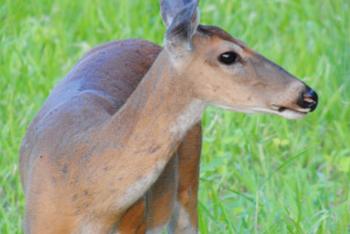
Doe at 97 yards.
Technology constantly evolves, and I know image stabilization is constantly being improved. I feel the new Nikon EDG VR fieldscope has taken image stabilization to new heights. I used the Nikon EDG VR fieldscope on a long range shooting expedition down East. The Nikon EDG VR fieldscope's image stabilization was amazing. Sitting with spotting scopes of equal power made by Leupold, and Swarovski, the EGD VR was clearly the best. In the early morning, before the mirage had gotten bad, the Swarovski and Nikon were very close in clarity, but with a 4 mph wind from the SE, even while mounted on the same tripods, the visual clarity of the Nikon was better. The small wind caused vibrations affecting the clarity in the Swarovski. As the wind increased, so did the perceptible movements of the Swarovski scope, and the visual clarity was compromised. With the Nikon EDG VR fieldscope's vibration system turned off, both scopes' images were identical. With the VR system engaged, all the movement caused by wind vanished, and the target was in full focus. As small thermals began to rise and form a mirage, the Nikon still outperformed its counterparts. While clarity was compromised at 1000 yards though all the scopes, the visual stabilization in the Nikon EDG VR fieldscope allowed a sharper image. I was actually able to see 7mm bullet holes at 500 yards through the Nikon, even with some mirage. I was not able to detect these bullet holes with either the other two scopes.
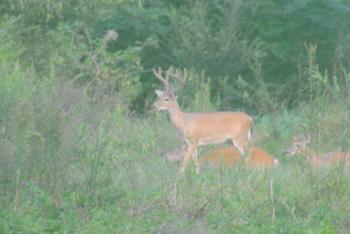
Three bucks at 287 yards, just past sunset.
I was only able to trial the scope for a few weeks, and the summer weather here in North Carolina was the wettest we have had in decades. All my weekend birding trips were rained out, so I had to do almost all my digiscope testing from the safety and weather protection of fully enclosed, weather proof deer stands during the week or when the weather allowed. From 100 yards to 500 yards, I was able to capture very clear, very vivid pictures of deer and other wildlife, but very few were in good light or sun. Because of that the F stop had to be adjusted for less light, and without the vibration reduction, most, if not all of these pictures would not have developed. I was able to catch the half open eye of a resting dove sitting on the power line almost 100 yards away, and unique hair patterns on the neck of a doe at the same distance.
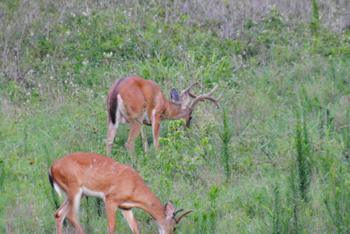
Bucks at 297 yards.
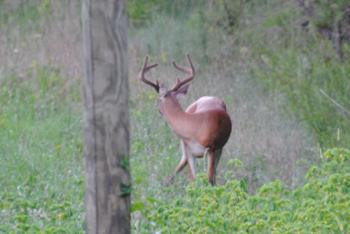
Buck at 177 yards.
I began "digiscoping" seven years ago with my smart phone camera and my rifle scope. I would then text the pictures to my hunting buddies so they could see what I was seeing. In those days, you could tell it was a deer, a bear or a coyote, but the details were lost in the poor quality camera, and in less than great magnification. My father and I then began experimenting with my his Swarovski setup, birding around Lake Mattamuskeet in eastern NC. In late January and early February, the lake is home to thousands of migratory ducks and geese, along with many other song birds. It is unfortunate I will not have this setup for those February birding trips this year, as I know it would perform perfectly on the ducks and geese.
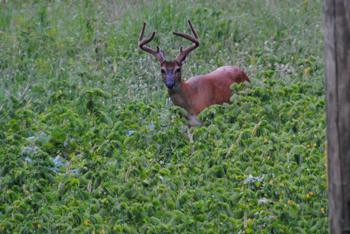
Buck at 169 yards.
Battery life was impressive on the unit. The Nikon EDG VR fieldscope has a positive "on" and "off" mode so it can be deactivated to save battery life when it is not needed. I had the unit in my possession for about 6 weeks, and never changed the batteries.
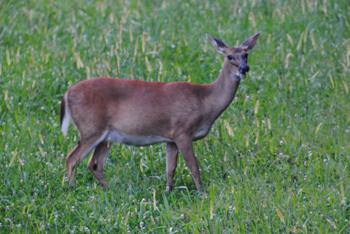
161 yards big doe.
If there were any negatives about the unit, it would be its weight, and total length when fitted with the adapter and a camera. I found it much easier to break the scope down into three sections to travel with it from stand to stand while digiscoping. The length and confined quarters of the deer stand also made birding difficult, certainly in the woods. Cardinals and thrashers were moving throughout the underbrush around the stand, but moving to another window, adjusting the sand bags, and finally finding and capturing the picture was very difficult. In a proper birding setting, this would not be an issue, so it is not a negative for the birder in proper weather and out in the open on a tripod or on sandbags on the hood of his truck. While the weight could be considered a negative, you also know you have a powerful piece of optical equipment in your hands when you hold the complete setup. Quality glass is not light in weight, nor is the frame to hold and protect it.
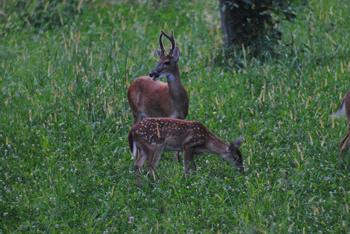
157 yards.
In my opinion, Nikon is a world class player in the optics industry. I personally have several Monarch rifle scopes, one set of Monarch binoculars, and have had the opportunity to trial this spotting scope. I have compared all these Nikon products to the industry leaders, and Nikon is definitely in the elite group of high end optics, and a certain leader with this new Nikon EDG VR fieldscope.
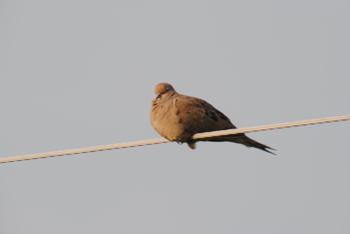
Sleeping doe at 100 yards.
Whenever I had this scope set up in public, it drew a small crowd. When people saw me giving a demonstration to another photographer, it caught their eye. "Why are you tapping on the scope while he is looking through it?" they would all ask. "Because it has a vibration reduction system that cancels out the motion and allows the image to be stabilized," was my standard response. Then, the onlooker would want to experience it for themselves, and some were so amazed, they tapped on the scope themselves. By this time, someone else would stop and the cycle would repeat.
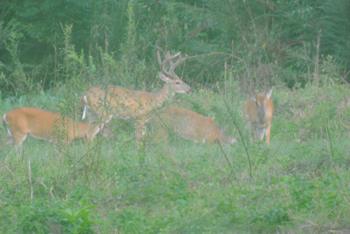
Deer at 287 yards after sunset.
If you are in the market for a top of the line spotting scope, or wanting to get into digiscoping, you owe it to yourself to give the Nikon EDG VR fieldscope a serious look. With its crystal clear glass and user friendly controls, it is an amazing scope. When you add the vibration reduction, it stands alone as the elite leader in optical clarity and function. Add a digital camera and you have a very powerful digiscoping system that allows tremendous flexibility in the field. Rig yourself with this system, and you will experience the "wow factor" of this amazing setup.
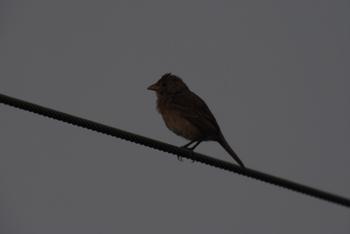
Sparrow at 72 yards at sunset.
Roger Seale has been an avid outdoorsman for the last 35 years. In the last 5 years he has become addicted to long range shooting and hunting. Roger likes them real close (archery) or real far away. He hones his skills all year with competitive shooting and predator hunting. Married and the proud father of two hunting daughters, both girls took their first deer at age 7, and both have taken deer past 300 yards.
By Roger Seale
Amazing! That was the first word to come out of anyone's mouth the first time they looked through the new Nikon EDG VR fieldspotter. Used as a spotting scope or hooked to a camera, the spotter offers extremely bright clear images without the distortion and vibration associated with all other scopes on the market. Sitting side by side with a Swarovski and Leupold, the Nikon EDG VR spotting scope shined. With the VR (Vibration reduction) button engaged, all visible motion through the eyepiece disappears. Even when the scope is being physically bumped, the image stays crystal clear and motionless.

Doe with hair pattern at 102 yards.
Nikon sent me the complete package to test this new field scope. Not only did I receive the Nikon EDG VR spotting scope, but they also sent me the Nikon D3100 digital SLR camera, along with the Nikon FSA-L1 digital SLR camera adapter. Setup of the camera and adapter could not have been easier, or more rock solid. Each attachment point was clearly marked, and when the units were connected together, they locked in with a satisfying snap, so you knew they were locked and loaded. Disassembly for travel was just as easy as the setup. A single charge of the rechargeable battery pack for the D3100 lasted for hundreds of pictures, and I never recharged the battery the whole time I had possession of the SLR camera. As with all current Nikon technology, the camera and the Nikon EDG fieldscope are very user friendly. The large LCD display on the camera allows the user to quickly adjust and set all functions of the camera effortlessly and the setup is very well thought out and in line with basic common sense. While a user's manual was sent with the unit, it was only needed for reference, not all aspects of the camera's operations.

Doe at 97 yards.
Technology constantly evolves, and I know image stabilization is constantly being improved. I feel the new Nikon EDG VR fieldscope has taken image stabilization to new heights. I used the Nikon EDG VR fieldscope on a long range shooting expedition down East. The Nikon EDG VR fieldscope's image stabilization was amazing. Sitting with spotting scopes of equal power made by Leupold, and Swarovski, the EGD VR was clearly the best. In the early morning, before the mirage had gotten bad, the Swarovski and Nikon were very close in clarity, but with a 4 mph wind from the SE, even while mounted on the same tripods, the visual clarity of the Nikon was better. The small wind caused vibrations affecting the clarity in the Swarovski. As the wind increased, so did the perceptible movements of the Swarovski scope, and the visual clarity was compromised. With the Nikon EDG VR fieldscope's vibration system turned off, both scopes' images were identical. With the VR system engaged, all the movement caused by wind vanished, and the target was in full focus. As small thermals began to rise and form a mirage, the Nikon still outperformed its counterparts. While clarity was compromised at 1000 yards though all the scopes, the visual stabilization in the Nikon EDG VR fieldscope allowed a sharper image. I was actually able to see 7mm bullet holes at 500 yards through the Nikon, even with some mirage. I was not able to detect these bullet holes with either the other two scopes.

Three bucks at 287 yards, just past sunset.
I was only able to trial the scope for a few weeks, and the summer weather here in North Carolina was the wettest we have had in decades. All my weekend birding trips were rained out, so I had to do almost all my digiscope testing from the safety and weather protection of fully enclosed, weather proof deer stands during the week or when the weather allowed. From 100 yards to 500 yards, I was able to capture very clear, very vivid pictures of deer and other wildlife, but very few were in good light or sun. Because of that the F stop had to be adjusted for less light, and without the vibration reduction, most, if not all of these pictures would not have developed. I was able to catch the half open eye of a resting dove sitting on the power line almost 100 yards away, and unique hair patterns on the neck of a doe at the same distance.

Bucks at 297 yards.

Buck at 177 yards.
I began "digiscoping" seven years ago with my smart phone camera and my rifle scope. I would then text the pictures to my hunting buddies so they could see what I was seeing. In those days, you could tell it was a deer, a bear or a coyote, but the details were lost in the poor quality camera, and in less than great magnification. My father and I then began experimenting with my his Swarovski setup, birding around Lake Mattamuskeet in eastern NC. In late January and early February, the lake is home to thousands of migratory ducks and geese, along with many other song birds. It is unfortunate I will not have this setup for those February birding trips this year, as I know it would perform perfectly on the ducks and geese.

Buck at 169 yards.
Battery life was impressive on the unit. The Nikon EDG VR fieldscope has a positive "on" and "off" mode so it can be deactivated to save battery life when it is not needed. I had the unit in my possession for about 6 weeks, and never changed the batteries.

161 yards big doe.
If there were any negatives about the unit, it would be its weight, and total length when fitted with the adapter and a camera. I found it much easier to break the scope down into three sections to travel with it from stand to stand while digiscoping. The length and confined quarters of the deer stand also made birding difficult, certainly in the woods. Cardinals and thrashers were moving throughout the underbrush around the stand, but moving to another window, adjusting the sand bags, and finally finding and capturing the picture was very difficult. In a proper birding setting, this would not be an issue, so it is not a negative for the birder in proper weather and out in the open on a tripod or on sandbags on the hood of his truck. While the weight could be considered a negative, you also know you have a powerful piece of optical equipment in your hands when you hold the complete setup. Quality glass is not light in weight, nor is the frame to hold and protect it.

157 yards.
In my opinion, Nikon is a world class player in the optics industry. I personally have several Monarch rifle scopes, one set of Monarch binoculars, and have had the opportunity to trial this spotting scope. I have compared all these Nikon products to the industry leaders, and Nikon is definitely in the elite group of high end optics, and a certain leader with this new Nikon EDG VR fieldscope.

Sleeping doe at 100 yards.
Whenever I had this scope set up in public, it drew a small crowd. When people saw me giving a demonstration to another photographer, it caught their eye. "Why are you tapping on the scope while he is looking through it?" they would all ask. "Because it has a vibration reduction system that cancels out the motion and allows the image to be stabilized," was my standard response. Then, the onlooker would want to experience it for themselves, and some were so amazed, they tapped on the scope themselves. By this time, someone else would stop and the cycle would repeat.

Deer at 287 yards after sunset.
If you are in the market for a top of the line spotting scope, or wanting to get into digiscoping, you owe it to yourself to give the Nikon EDG VR fieldscope a serious look. With its crystal clear glass and user friendly controls, it is an amazing scope. When you add the vibration reduction, it stands alone as the elite leader in optical clarity and function. Add a digital camera and you have a very powerful digiscoping system that allows tremendous flexibility in the field. Rig yourself with this system, and you will experience the "wow factor" of this amazing setup.

Sparrow at 72 yards at sunset.
Roger Seale has been an avid outdoorsman for the last 35 years. In the last 5 years he has become addicted to long range shooting and hunting. Roger likes them real close (archery) or real far away. He hones his skills all year with competitive shooting and predator hunting. Married and the proud father of two hunting daughters, both girls took their first deer at age 7, and both have taken deer past 300 yards.

